Anatomy of a Photograph
An analysis of a single seemingly innocuous photograph, and the pervasive media bias it reveals.
My photo essay of the anti-war protest in San Francisco on September 24, 2005 was not the only report done about the event. A few other outlets ran their own coverage. But the one photo from the rally that was seen by the most people was this:
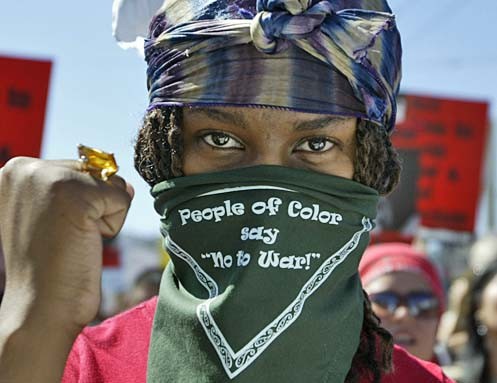
Why? Because the San Francisco Chronicle, which had the only mainstream media coverage of the rally, published this photograph on the front page of its Web site as a teaser for their article about the event.
Now, let's take a closer look at this image.
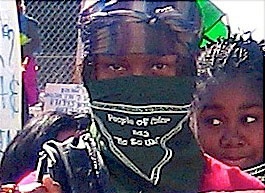
By chance, I took a photo of the same girl just a few moments later. Looks practically identical, doesn't it?
But you might notice that my picture is lower resolution. That's because it's a zoomed-in portion of a much larger photograph. I cropped off the other parts of the picture to get a close-up of the girl.
But what would happen if I hadn't cropped off so much? Let's take a step backward and reveal what the San Francisco Chronicle didn't want you to see.
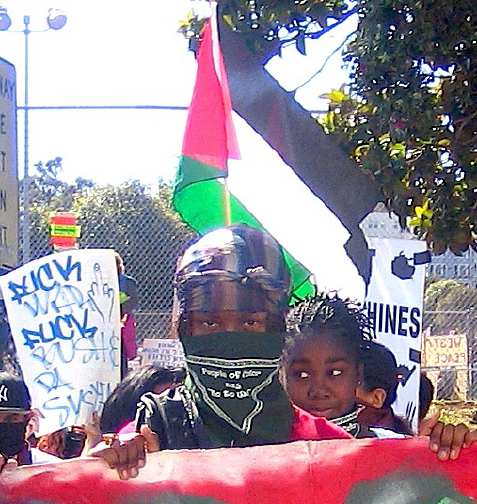
Here's the same photo without as much cropping, revealing more of the context. You can see that the girl's protest contingent also sported Palestinian flags and obscene placards.
Now let's take another step back.
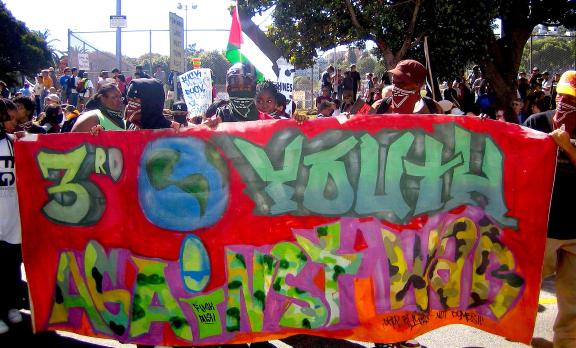
Here's my full original photo, uncropped. Now we can see that the girl is just one of several teenagers, all wearing terrorist-style bandannas covering their faces.
But, as you'll notice, the bandannas are all printed with the same design. Was this a grassroots protest statement the teenagers had come up with all by themselves?
To find out, let's take a look at another photo in the series, taken at the same time:
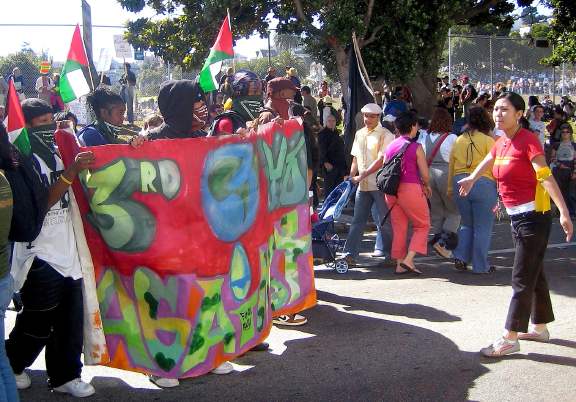
Oops -- it looks like they're actually being stage-managed by an adult, who is giving them directions and guiding them toward the front of the march. But who is she?
The last picture in the series reveals all.
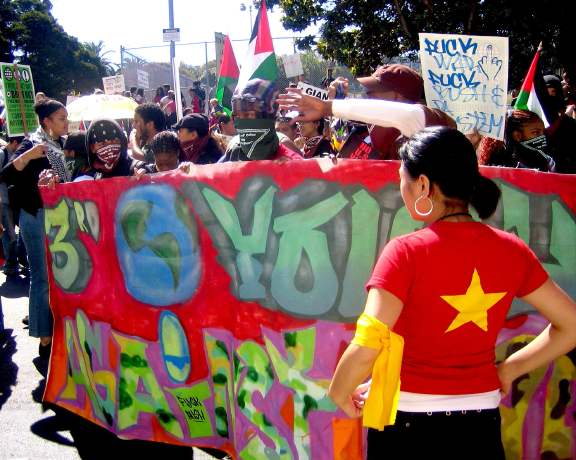
It turns out that the woman giving directions belongs to one of the Communist groups organizing the rally -- if her t-shirt is to be believed, since it depicts
the flag of Communist Vietnam, which has been frequently displayed by such groups at protest rallies in the U.S. for decades.
The San Francisco Chronicle featured the original photograph on its front Web page in order to convey a positive message about the rally -- perhaps that even politically aware teenagers were inspired to show up and rally for peace, sporting the message, "People of Color say 'No to War!'" And that served the Chronicle's agenda.
But this simple analysis reveals the very subtle but insidious type of bias that occurs in the media all the time. The Chronicle did not print an inaccuracy, nor did it doctor a photograph to misrepresent the facts. Instead, the Chronicle committed the sin of omission: it told you the truth, but it didn't tell you the whole truth.
Because the whole truth -- that the girl was part of a group of naive teenagers recruited by Communist activists to wear terrorist-style bandannas and carry Palestinian flags and obscene placards -- is disturbing, and doesn't conform to the narrative that the Chronicle is trying to promote. By presenting the photo out of context, and only showing the one image that suits its purpose, the Chronicle is intentionally manipulating the reader's impression of the rally, and the rally's intent.
Such tactics -- in the no-man's-land between ethical and unethical -- are commonplace in the media, and have been for decades. It is only now, with the advent of citizen journalism, that we can at last begin to see the whole story and realize that the public has been manipulated like this all along.
--------------------------------------------------------------------------------------------------------------------------------------
UPDATE: This essay has caused such an outcry that the San Francisco Chronicle has now (on October 2, 2005) run a column about zombietime and the controversy surrounding the photo, defending itself from charges of bias. You can read the column here. (Someone at the Chronicle also wrote to me directly and rather brazenly requested that I update my site with a link to their response -- which I have just done -- although they purposely did not include a link to "Anatomy of a Photograph" in their column. They insist that I allow my readers to see the Chronicle's side of the story, but they won't let their readers see my side of the story. Again, the whiff of arrogance.)
Some of the Chronicle's defensiveness is the result of the paper's having been barraged by emails from zombietime readers, some of whom slightly misinterpreted a couple of points in my analysis above. Please note that I do not claim that the Chronicle cropped its photograph, which is obviously a high-resolution close-up and thus not cropped much, if at all; I only discuss cropping my photograph. I also didn't say that the Chronicle ran the photo on the front page of its print edition, but rather on the front page of its online edition.
Part of the Chronicle's attempted rebuttal is the claim that, since some of my readers jumped to the conclusion that the picture was on the front page of the print edition, this somehow constituted an "error" on my part that I refuse to acknowledge. I think that it should be fairly universally understood that when a Web site provides a link to an article or photo it is discussing, it is referring to the online version. Blogs and media-related Web sites deal pretty much exclusively with information and links that are online.
The Chronicle also defends itself by saying that its article about the rally did mention a few of the controversial aspects of the event. A defense which, to me, misses the mark on two counts: first, "Anatomy of a Photograph" was specifically about the Chronicle's photo coverage (and the decision to highlight one specific photograph), not about the textual news article; and second, its article only very peripherally referred to a couple of radical elements, and glossed over almost all of the extremism that was manifested at the rally.
And lastly, the Chronicle claims that the photo was chosen because it was visually arresting, not for any political considerations. And of course the photo is a good image, based solely on stylistic characteristics: the girl is pretty, and her face is in sharp focus.
But this brings up a larger issue concerning media coverage of these events. Newspapers and other mainstream outlets run photos that almost always fall into these four categories:
a. Wide shots of the crowd at a distance, in which individual messages aren't clearly visible. A good example is this photo in the Chronicle (oops, I mean: on the Chronicle's Web page).
b. Close-ups of individuals' faces, with no message visible -- as in this example from the Chronicle.
c. Human-interest images of people, in which the political aspect is peripheral or cut off, as in this photo.
d. Mid-range shots of people displaying "safe," non-controversial messages, like the one visible here.
Now, there's nothing wrong with any of these kinds of photographs; each, in its own way, is a valid type of image. But what media outlets rarely publish are the kind of photographs that I feature on zombietime: mid-range images focusing on individual protesters displaying their heartfelt (and often intense) messages. And that's all a rally is really composed of: thousands of individuals, each with their own messages. By showing them as an overall group, or by showing the individuals without their messages, or by showing only non-controversial messages, media outlets (probably unconsciously) influence the public's impressions of such events as being somewhat less disturbing and less politically radical than they really are.
Yet the public is hungry for the type of uncompromising, in-your-face photography that can be found on zombietime and similar Web sites and blogs, since we show the kind of images that simply can't be found in mainstream media outlets. At least 250 Web sites linked to zombietime's photo coverage of the September 24 rally. How many sites specifically linked to the Chronicle's photo coverage? (The answer: None.)
If the Chronicle is truly unbiased in its coverage (which I doubt rather strongly: I know several Chronicle staffers, and have been in the Chronicle offices, and I can say that there is -- as there is at most major newspapers -- an overall left-wing/"progressive" atmosphere at the paper), and if it wants to increase readership, then it should take a close look at how it frames and reports on certain issues. Whitewashing potential controversies, or lazily presenting unchallenged the narrative of people or groups it is covering, only leads to a bland paper and a bored readership.
--------------------------------------------------------------------------------------------------------------------------------------
UPDATE 2: See more analysis of the S.F. Chronicle's bias in this zombietime report.
Return to zombie's main September 24, 2005 anti-war rally page.
